The A6500 remains the top-ranked APS-C hybrid we’ve tested, however, with class-leading Portrait and Landscape scores offering exceptional image quality for landscape, portrait, architectural, and street photographers, as well as for photojournalists after the convenience of a smaller camera body. Updates over the A6300 center around new and improved features, including a bigger buffer for longer continuous burst shooting, a LCD touchscreen, and the inclusion of Sony’s 5-axis SteadyShot INSIDE image stabilization system.
Highlights
- Large APS-C sensor
- Class leading sensor scores
- 5-axis image stabilization
- LCD touchscreen
- Larger buffer
- 4k video
Potential drawbacks
- Same image quality as the Sony A6300
- sizeable premium over the Sony A6300
Overall image quality
The Sony A6500’s large 24.2Mp APS-C sensor delivers excellent all-round image quality, boasting class-leading scores in the APS-C mirrorless category alongside its sister model, the A6300. At base ISO, its exceptional dynamic range of 13.7 EV ensures plenty of tonal sensitivity for landscape and architectural photography, and the A6500 comes very close to matching the dynamic range of such Sony full-frame hybrid cameras as the A7R II up to ISO 800.
Above ISO 800, the full-frame sensors start to pull away, but the A6500 still maintains good dynamic range over 10 EV up to ISO 3200. The A6500 is capable of excellent color depth around 24 bits at ISO 100 and ISO 200, as well as maintaining good color sensitivity over 20 bits up to ISO 1600, making it a suitable option for portraits in low light. For low light ISO performance, it achieves excellent signal-to-noise ratios (SNR 18%) of over 37 dB up to ISO 400, with good results around 32 dB still possible up to ISO 1600.
Image quality compared
Using the same 24.2Mp APS-C sensor as its predecessor, the A6500 achieves almost identical DxOMark sensor scores as the A6300, so we can say that they offer essentially the same overall image quality. That’s no bad thing, however, as both models boast class-leading scores in our database for hybrid cameras featuring an APS-C sensor.
Comparing the A6500’s image quality results to those of the full-frame sensors in Sony’s A7 hybrid cameras, we see that while the headline dynamic range scores are pretty close, the bigger sensors offer advantages for both color and ISO.
That is particularly true for the 42.4Mp Sony A7R II, which offers around a one-stop advantage for color depth at base ISO, scoring 26 bits vs. 24.5 bits, and over one stop better low-light ISO performance (3434). So while the A6500’s low-light ISO score of 1405 remains the best-in-class for APS-C sensor hybrid cameras, it’s far behind the best full-frame sensor results.
In addition to reduced levels of noise, these full-frame sensors often display an improvement in dynamic range and color depth at mid-to-high ISO sensitivity settings as a result of improved ISO performance, which we will see in more detail below.
Image quality: Low-light ISO
With the exception of a very modest improvement in SNR at ISO 400 and ISO 800, which would have a very limited impact on real-world results, the Sony A6300 and Sony A6500 offer the same low-light ISO results throughout the sensitivity range.
With a physically smaller APS-C sensor and resulting reduced pixel pitch, the A6500 is more prone to noise compared to Sony full-frame hybrids. The full-frame sensors in the Sony A7R II and A7 II offer around a one-stop improvement compared to the A6500 throughout the sensitivity range, with excellent SNR 18% results around 38 dB possible on the 42.4Mp Sony A7R II up to ISO 800, compared to 37 dB on the A6500 at ISO 400. The advantage isn’t as pronounced on the 24.2Mp A7 II, but it continues to offer a low-light advantage at all sensitivities compared to the A6500.
Image quality: Dynamic range
Aside from the small performance peak visible in the chart above at ISO 400 and 800, the A6500 and A6300 offer the same levels of dynamic range throughout the sensitivity range, achieving the best results of over 10 EV up to ISO 3200.
The 24.2Mp APC-S A6500 and 24.4Mp full-frame A7 II models offer identical dynamic range results up to ISO 1600, at which the smaller sensor camera actually shows a modest improvement between ISO 3200 to ISO 25,600, but the difference isn’t significant.
The A6500 also isn’t far behind the 42.4Mp full-frame Sony A7R II for dynamic range up to ISO 1600, but the larger sensor pulls away at mid-ISO sensitivities, offering similar levels of dynamic range of around 10 EV at ISO 6400 as the A6500 does at ISO 3200.
Image quality: Color depth
For Portrait color depth results, the same trend is evident between the A6300 and A6500, which offer almost identical results throughout the sensitivity range, aside from a small improvement for color on the A6500 at ISO 400 and ISO 800.
The Sony A6500 and Sony A7 II achieve very similar color depth results throughout the sensitivity range, but again, the higher-resolution Sony A7R II is ahead, offering around one stop better color throughout the sensitivity range, and 20-bit color depth at ISO 3200 similar to the A6500 at ISO 1600.
Conclusion
With the new Sony A6500 mirrorless hybrid featuring the same 24.2Mp APS-C sensor as its predecessor, the A6300, it’s no surprise that the two cameras offer almost identical image quality results. Both are top-performing hybrid options, with class-leading scores for hybrid APS-C sensors in all categories, and both offer exceptional image quality at the lower end of the ISO sensitivity range. For landscape, portrait, architectural, and street photographers, or for photojournalists looking for a small, compact, and convenient hybrid camera solution that offers great results up to ISO 1600, the A6500 is an excellent choice.
Better overall image quality and improved low-light performance is available in the hybrid market by stepping up to a full-frame model such as the Sony A7R II, however, which is one of the best-performing cameras we’ve tested. This said, the A7R II is a significantly bigger investment, and with larger and heavier lenses required for full-frame shooting, the overall size of a full-frame hybrid might be too much for some photographers. But if it’s an APS-C hybrid you’re after, the A6500’s updated features, including a bigger buffer for longer continuous bursts, a LDC touchscreen, and built-in image stabilization, might be attractive. If you can live without these additions, however, the A6300 is cheaper and offers the same excellent image quality as the new Sony A6500.
For further consideration
For greater insight into the image-quality capabilities of the Sony A6500’s main competitors, please refer to our in-depth reviews for the Sony A6300, the Samsung NX1, the Sony A7R II, and the Sony A7S.
Specifications
- 24.2Mp APS-C Exmor CMOS sensor (6024×4024 pixels)
- 12 bits per pixel
- BIONZ X image processor
- ISO 100 – 51200
- 11 fps burst shooting up to 300 JPEG / 44 RAW files
- 2.36m-dot OLED electronic viewfinder (EVF)
- 3-inch 921k-dot articulated LCD touchscreen
- 5-axis SteadyShot INSIDE image stabilization
- Built-in wi-fi and NFC connectivity
- UHD 4K-video up to 30fps
- Full HD video up to 120 fps







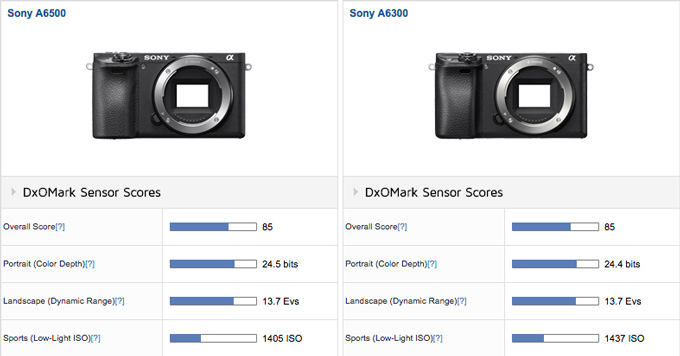

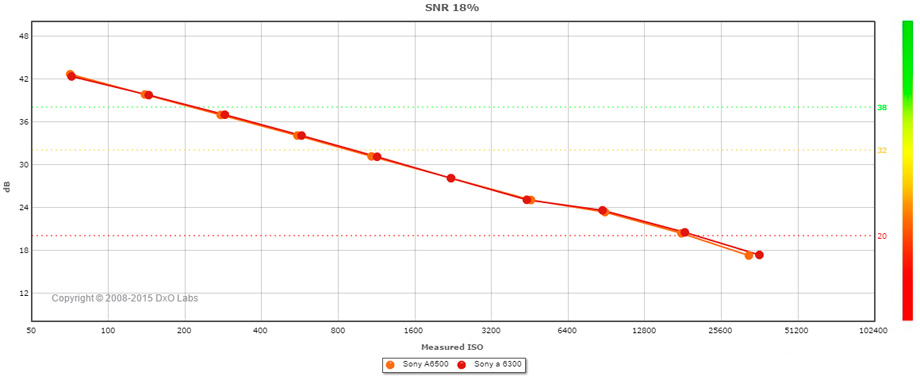
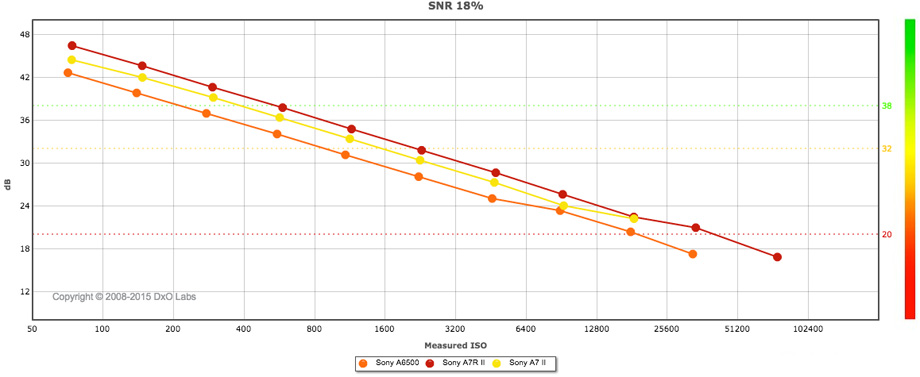
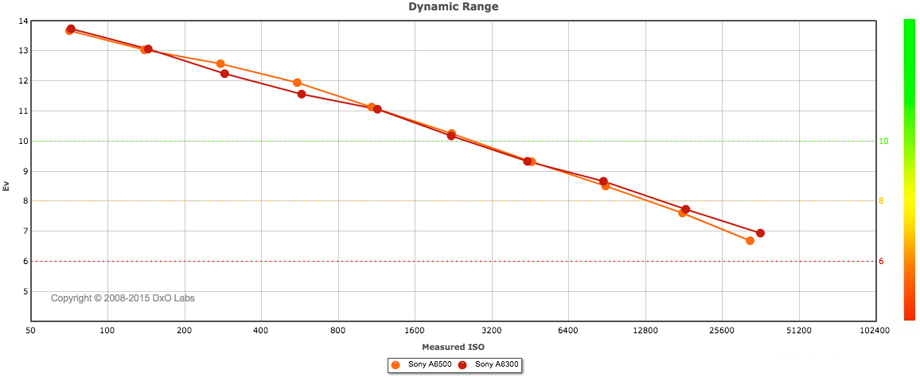
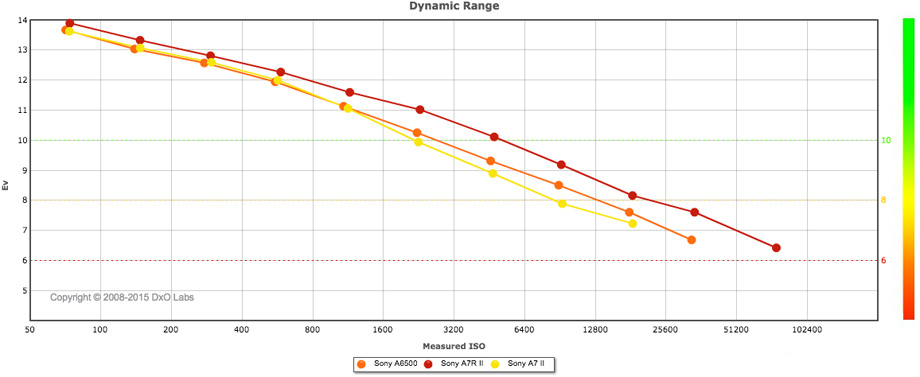
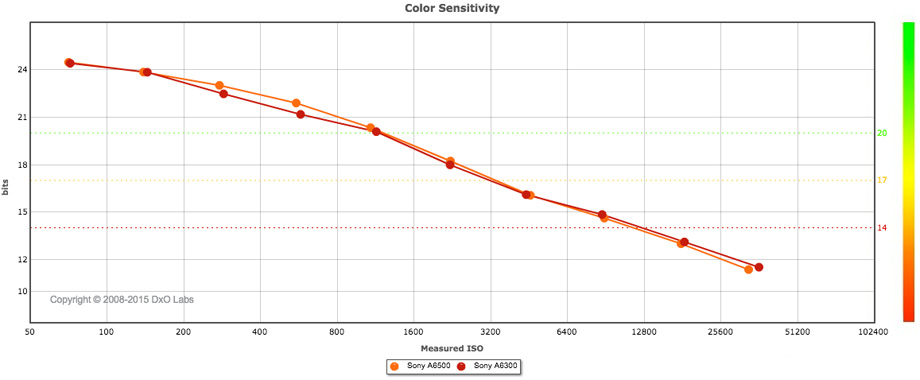

DXOMARK encourages its readers to share comments on the articles. To read or post comments, Disqus cookies are required. Change your Cookies Preferences and read more about our Comment Policy.